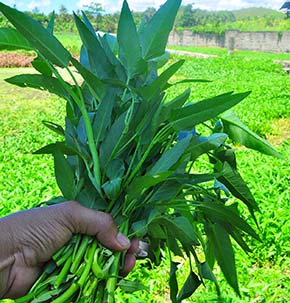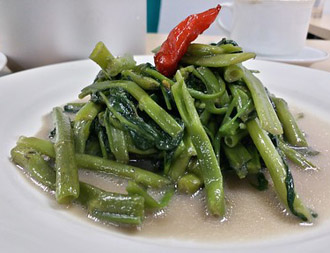Kangkong (Water-Spinach) Nutrition Facts
Kangkong, also known as water spinach, is a popular leafy vegetable commonly used in South and Southeast Asian cuisine.
Appreciated for its mildly sweet flavor and tender, slightly slippery texture, kangkong is often added to salads, braised dishes, and stir-fries.
Although it belongs to the Convolvulaceae family and is botanically related to sweet potatoes, kangkong has little in common with true spinach. Scientific name: Ipomoea aquatica Forsk.Despite belonging to the Convolvulaceae family and sharing a botanical relation with , Kangkong bears little resemblance to conventional spinach.
Scientific Name: Ipomoea aquatica Forsk.
 |
| Water spinach greens (Photo-by Whologwhy) |
The water spinach plant features smooth, hollow stems reminiscent of watercress, earning it the moniker “hollow-stemmed vegetable” (Kung Shin Tsai- 空心菜) in China. Its vibrant green, lanceolate leaves vary in size, ranging from 2.5 to 8 cm in width. Although white, trumpet-shaped flowers with purple centers appear at later stages, they are usually absent in actively harvested plants.
Two distinct varieties of water spinach are recognized based on their growth habits:
The tall, erect variety thrives in soil rich in organic matter and moisture. It develops new roots at the inter-nodal junctions, which, upon contact with the soil, anchor the plant and extend further, giving it a creeper-like appearance.
The semi-aquatic variety, commonly called "swamp cabbage", flourishes in swampy terrain. Its primary root is firmly anchored in the soil, while secondary (adventitious) rootlets at the inter-nodes either float freely in the water or, upon contact with the soil, take hold and provide additional support.
Health Benefits of Kangkong (Water Spinach)
Kangkong greens provide a wealth of health benefits, beginning with their low calorie and fat content. Despite being light and delicate, these succulent leaves are packed with vital nutrients, particularly vitamin A (6,600 IU per 100 grams), along with a rich array of antioxidants and minerals.
With just 19 calories per 100 grams of fresh leaves, kangkong is highly valued by nutritionists for cholesterol management and weight-loss programs, thanks to its antioxidant-rich, low-calorie, and low-fat profile.
Fresh water spinach leaves are abundant in phenolic antioxidants such as ß-carotene, lutein, xanthin, and cryptoxanthin.
Raw kangkong leaves also contain impressive levels of ascorbic acid (vitamin C). In fact, 100 grams provide 55 mg, or 92% of the daily recommended intake of vitamin C. This powerful antioxidant helps neutralize free radicals and reactive oxygen species (ROS), protecting the body against oxidative stress and various diseases.
Regular consumption of vitamin C-rich foods supports connective tissue repair, hair and skin health, and helps prevent iron-deficiency anemia. It may also delay aging and offer protection against certain cancers.
Kangkong greens are an excellent source of vitamin A, comparable to other leafy greens such as spinach, kale, and watercress. With 6,300 IU, or 210% of the daily recommended value per 100 grams, vitamin A supports mucosal integrity, hair and skin health, vision, and also functions as an anti-cancer and anti-aging nutrient at the cellular level.
These greens are further enriched with B-complex vitamins, including riboflavin, niacin, vitamin B6, and folic acid, all of which play critical roles in energy metabolism and overall health.
Additionally, kangkong is a valuable source of essential minerals such as iron, calcium, potassium, magnesium, manganese, and phosphorus. These minerals contribute to bone and teeth mineralization, regulate heart rhythm, and serve as cofactors for antioxidant enzymes such as superoxide dismutase.
Altogether, kangkong greens are a powerhouse of health-promoting nutrients. Regular consumption is associated with the prevention of osteoporosis, iron-deficiency anemia, and vitamin A deficiency. They are also believed to help protect against cardiovascular disease, colon cancer, and prostate cancer.
| Principle | Nutrient Value | Percent of RDA |
|---|---|---|
| Energy | 19 kcal | 1% |
| Carbohydrates | 3.14 g | 2% |
| Protein | 2.6 g | 4.5% |
| Total Fat | 0.20 g | 1% |
| Cholesterol | 0 mg | 0% |
| Dietary Fiber | 2.1 g | 5.5% |
| Vitamins | ||
| Folates | 57 µg | 14% |
| Niacin | 0.900 mg | 5.5% |
| Pantothenic acid | 0.141 mg | 3% |
| Pyridoxine | 0.096 mg | 7% |
| Riboflavin | 0.100 mg | 8% |
| Thiamin | 0.030 mg | 2.5% |
| Vitamin A | 6300 IU | 210% |
| Vitamin-C | 55 mg | 92% |
| Electrolytes | ||
| Sodium | 113 mg | 7.5% |
| Potassium | 312 mg | 6.6% |
| Minerals | ||
| Calcium | 77 mg | 8% |
| Copper | 0.023 mg | 2.5% |
| Iron | 1.67 mg | 21% |
| Magnesium | 71 mg | 18% |
| Manganese | 0.160 mg | 7% |
| Phosphorus | 39 mg | 5.5% |
| Selenium | 0.9 µg | 1.5% |
| Zinc | 0.18 mg | 1.5% |
Selection and Storage
Water spinach, also known as kangkong, is typically ready for harvest about 45 days after seeding. During harvesting, pick the tender top shoots while leaving about 2 inches of the lower stem intact to encourage regrowth for future harvests. For the best flavor, it is recommended to harvest the plant before it begins to bloom.
When purchasing water spinach at markets, it is usually sold in bundles of varying sizes and weights. Choose bundles with deep green, broad leaves, as these generally offer a richer flavor than those with smaller leaves.
Avoid bundles with wilted or yellowing leaves, as well as those showing signs of damage or insect infestation.
Water spinach is delicate and prone to damage if not stored properly. To preserve freshness, wrap the leaves in a damp towel and refrigerate them, just as you would store other leafy greens like spinach.
Preparation and Serving methods
In much the same way as watercress, this leafy green thrives in aquatic environments. Therefore, it is essential to wash it thoroughly under clean running water, then soak it in salt water for about half an hour to eliminate parasite eggs and worms that often thrive in such conditions.
After rinsing, pat it dry with a soft cloth or paper towel. Use a paring knife to chop the leaves and trim away any tough stems. Young, tender shoots can be eaten raw in salads, while larger leaves are best cooked before consumption.
Kangkong greens have a mild, subtly sweet flavor and a slightly mucilaginous texture. Steaming or braising enhances their unique taste while balancing the contrast between crunchy stems and soft, succulent leaves. They can be sautéed with butter and garlic, tossed with a splash of vinegar, and finished with toasted sesame seeds. Boiled greens may also be served creamed and topped with grated cheese.
Here are some serving tips:
 |
| Tumis kangkung-Stir-fried water-spinach. (Photo by Farhan Perdana) |
Fresh, tender kangkong shoots make excellent additions to green salads.
The young stems and leaves can be boiled, steamed, or sautéed in oil for various dishes, including stews and curries.
In Indonesian cuisine, "Tumis kangkung" is a popular stir-fry made with water spinach, chilies, and shrimp paste.
Finely chopped kangkong stems and leaves can be sautéed with garlic and used as a filling for momos (dim sum).
Kangkong also serves as an excellent substitute for other leafy greens such as spinach, chard, basella, and sorrel in many recipes.
Safety Profile
Aquatic plants like kangkong greens may harbor water-borne pests that can cause intestinal infections such as flukes (F. buski).
The larval stages of these trematodes, known as metacercariae, often encyst on various aquatic plants including water-spinach, water chestnut, water caltrop, lotus root, and other edible greens. Consuming raw, unwashed greens may lead to symptoms such as stomach pain, diarrhea, fever, allergic reactions to the larvae, and, in severe cases of infestation, intestinal obstruction.
To reduce risks, purchase from reputable farms that use clean water for irrigation, and avoid greens grown in stagnant or polluted water sources.
(Medical disclaimer).
Read further on:
≺≺ What foods can lower prostate cancer risk?
≺≺ What are antioxidants? How antioxidants in the fruits and vegetables help in preventing cancers and diseases?
≺≺ Which food is most associated with helping people live longer?
≻≻ -Back to Vegetables from Kangkong (water spinach). Visit here for an impressive list of vegetables with complete illustrations of their nutrition facts and health benefits.
≻≻ -Back to Home page.
Further reading:
Water spinach- pdf.
University of Hawaii at manoa-Ung Choi: Postharvest Quality-Maintenance Guidelines. -pdf